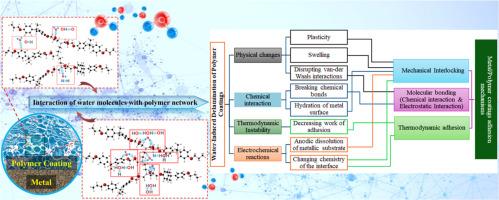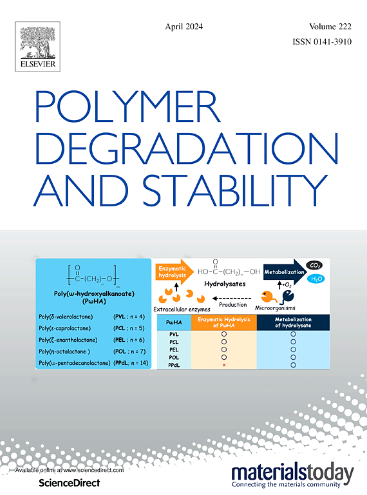聚合物涂层因水引起的失效:机理、影响和缓解策略--综合评述
IF 6.3
2区 化学
Q1 POLYMER SCIENCE
引用次数: 0
摘要
在为提高金属结构完整性而实施的各种策略中,聚合物涂层因其具有成本效益和持久保护的能力而成为一种引人注目的选择。然而,湿度是一个关键的环境因素,会对聚合物涂层的完整性构成风险,表现为尺寸改变、诱发内应力、涂层与基体之间的附着力减弱、微观结构变化和水解降解。其中许多有害变化直到涂层失效的后期才被发现。了解聚合物涂层的水诱导降解机制对于提高其保护效果、确保安全性和可靠性、最大限度地减少对经济和环境的影响以及促进创新和遵守法规至关重要。本研究严格探讨了聚合物涂层的水诱导失效机理,重点关注腐蚀、阴极分层和起泡等可见降解迹象,以及水解、溶胀和塑化等不太明显的现象。从水扩散的初始阶段到涂层的最终分层,都对扩散机制以及水分子和涂层成分之间的相互作用进行了仔细研究。此外,本综述还探讨了每种现象对涂层完整性的独特而又相互关联的影响,以及潜在的缓解策略。综述最后提出了旨在加强涂层结构完整性的实用建议。本文章由计算机程序翻译,如有差异,请以英文原文为准。

Water-induced failure in polymer coatings: Mechanisms, impacts and mitigation strategies—A comprehensive review
Among the various strategies implemented to improve the integrity of metallic structures, polymer coatings have emerged as a compelling choice due to their capacity to offer cost-effective and enduring protection. However, humidity is a critical environmental factor that poses a risk to the integrity of polymer coatings, manifesting in dimensional alterations, induced internal stresses, diminished adhesion strength between coating and substrate, microstructural changes, and hydrolytic degradation. Many of these detrimental changes remain concealed until the advanced stages of coating failure. Comprehending the water-induced degradation mechanisms in polymer coatings is crucial for improving their protective effectiveness, ensuring safety and dependability, minimizing economic and environmental impacts, and promoting innovation and regulatory compliance. This study rigorously explores the water-induced failure mechanisms in polymeric coatings, highlighting both visible signs of degradation, such as corrosion, cathodic delamination, and blistering, and less apparent phenomena like hydrolysis, swelling, and plasticization. From the initial stages of water diffusion to the eventual delamination of the coating, diffusion mechanisms and the interaction between water molecules and coating constituents are scrutinized. Moreover, this review explores the distinctive and interrelated impacts of each phenomenon on the integrity of the coating, along with potential mitigation strategies. The review culminates with practical recommendations aimed at bolstering the integrity of coated structures.
求助全文
通过发布文献求助,成功后即可免费获取论文全文。
去求助
来源期刊

Polymer Degradation and Stability
化学-高分子科学
CiteScore
10.10
自引率
10.20%
发文量
325
审稿时长
23 days
期刊介绍:
Polymer Degradation and Stability deals with the degradation reactions and their control which are a major preoccupation of practitioners of the many and diverse aspects of modern polymer technology.
Deteriorative reactions occur during processing, when polymers are subjected to heat, oxygen and mechanical stress, and during the useful life of the materials when oxygen and sunlight are the most important degradative agencies. In more specialised applications, degradation may be induced by high energy radiation, ozone, atmospheric pollutants, mechanical stress, biological action, hydrolysis and many other influences. The mechanisms of these reactions and stabilisation processes must be understood if the technology and application of polymers are to continue to advance. The reporting of investigations of this kind is therefore a major function of this journal.
However there are also new developments in polymer technology in which degradation processes find positive applications. For example, photodegradable plastics are now available, the recycling of polymeric products will become increasingly important, degradation and combustion studies are involved in the definition of the fire hazards which are associated with polymeric materials and the microelectronics industry is vitally dependent upon polymer degradation in the manufacture of its circuitry. Polymer properties may also be improved by processes like curing and grafting, the chemistry of which can be closely related to that which causes physical deterioration in other circumstances.
 求助内容:
求助内容: 应助结果提醒方式:
应助结果提醒方式:


